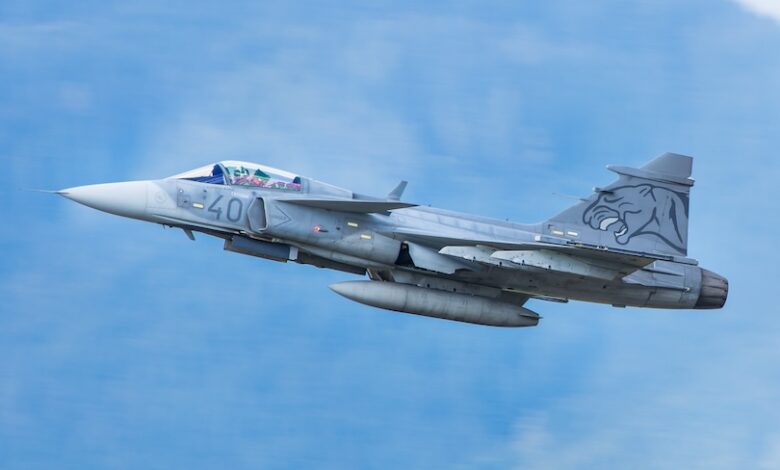Sweden’s Fighter Jet is Under America’s Thumb

Canadian Prime Minister Mark Carney has argued that Canada should consider acquiring the Saab Gripen instead of the F-35 because doing so would reduce American leverage over Canadian defense policy. The idea has been repeated by a number of Canadian commentators and policy wonks who claim the acquiring the F-35 compromises Canadian sovereignty, while purchasing the Gripen offers strategic autonomy. This argument sounds appealing—until you spend five minutes actually looking at how the defense industrial base and related supply chains work in the real world. Once you do that, the notion that the Gripen offers geopolitical independence is revealed for what it is – not just nonsense, but nonsense upon stilts.
The Gripen has always enjoyed a kind of underdog prestige. Lightweight, agile, cheaper than its competitors, it’s been held up as the smart choice for countries that don’t want to be caught in the gravitational pull of Washington or Brussels. On paper, it looks great—modern sensors, electronic warfare capabilities, STOL performance, and the ability to operate from remote or improvised airstrips. It’s easy to see why it has its fans. None of that changes the fact that the Gripen E runs on an American engine: the General Electric F414-GE-39E. This is the same engine that powers the U.S. Navy’s Super Hornet. It’s made in the United States and subject to the same American export controls as any other U.S.-manufactured military component. That means Washington can veto any Gripen sale, to any country, at any time. And it has.
In early 2025, Colombia was preparing to acquire the Gripen E. Saab’s offer was strong—cost-effective, technically capable, and tailored to Colombia’s airspace and operational needs. They even included incentives to build up local industry. But as the deal neared finalization, word leaked that the U.S. government intended to block the export of the F414 engine. And just like that, the entire thing collapsed. That wasn’t a bureaucratic delay or a paperwork issue. It was Washington exercising its legal authority under the International Traffic in Arms Regulations—ITAR—and it killed the deal.
This isn’t a one-off. India’s Tejas MkII, which also uses the F414, is under the same set of export restrictions. So is Brazil’s Gripen program. Even if those jets are assembled in São Paulo instead of Linköping, Washington still gets a say in where they can be sold. Every aircraft that relies on a U.S.-made component—especially something as critical as an engine—is, by definition, not fully sovereign.
The notion that Canada can somehow sidestep American influence by choosing the Gripen over the second batch of F-35s is pure fantasy—especially since Ottawa has already bought and paid for the first 16 of the planned 88 fighters. Both jets rely on the U.S. defense industrial base. Both are enmeshed in American supply chains. Both are constrained by ITAR. The only real difference is that the F-35 comes with built-in integration with NATO allies, common logistics, and a robust sustainment pipeline, while the Gripen comes with more isolation—and offers no more autonomy.
Sweden has always taken pride in its independent defense posture. Saab is a symbol of that tradition—a Cold War legacy of neutrality backed by credible indigenous production. But that model doesn’t scale cleanly into the 21st century. Fighter jets today are complex, multinational systems. No one builds everything in-house anymore. And Saab’s decision to use an American engine in its flagship export fighter effectively handed the U.S. a veto over its sales. It’s a decision that made sense from a technical and cost perspective, but it came with political consequences.
What’s striking is how many people in Ottawa—and now in the Prime Minister’s Office—don’t seem to understand this. Defense policy isn’t just about selecting a platform. It’s about understanding the ecosystems those platforms are embedded in. The F-35 may come with a big sticker price, but at least it comes with a network. The Gripen doesn’t buy you sovereignty; it buys you the illusion of it. You’re still dependent on Washington’s permission slip, only now you don’t have the operational benefits that come with being inside the tent – and fielding the superior fighter.
This is the bigger problem with the Gripen argument. It reflects a kind of magical thinking that’s far too common in Canadian defense debates: that we can somehow buy sovereignty off the shelf, that the right procurement decision will free us from the realities of our alliances and dependencies. That’s not how any of this works. If Canada wants real strategic autonomy, it’s going to have to invest in its own industrial base. That means propulsion, munitions, sustainment, and systems integration. And that’s simply never going to happen. The illusion that Canada can achieve the same goal simply by picking a Swedish jet – one powered by an American engine – is not simply an illusion, it’s a delusion.
The truth is uncomfortable but straightforward. Canada’s airpower is, and for the foreseeable future will be, tied to the American defense industrial based and therefore subject to American laws and regulations. That’s not a bug—it’s a feature of the Western defense-industrial ecosystem. The F-35 makes that relationship explicit. The Gripen obscures it, but it doesn’t change it.
Prime Minister Carney’s suggestion that purchasing the Gripen instead of the F-35 will keep Canada out of Washington’s clutches is simply not credible. Worse, it promotes a false sense of freedom where none exists. If Ottawa is going to take defense seriously, it needs to deal in strategic reality—not romantic myths about neutrality and independence that were obsolete a generation ago. Canada doesn’t need another grand gesture. It needs capability, clarity, and a defense policy rooted in how the world actually works.
Further Reading on E-International Relations
https://www.e-ir.info/wp-content/uploads/2025/03/shutterstock_2340327647.jpg
2025-03-30 10:11:05




